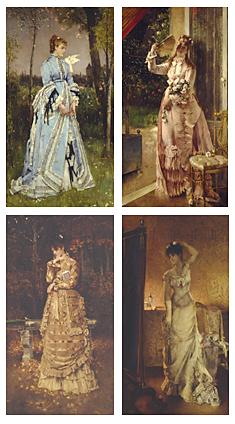
october 18, 2000–april 8, 2001
The four seasons
As early as 1857 Stevens had exhibited a painting titled Spring. In 1874, following a commission from Leopold II, king of the Belgians, Stevens completed the cycle of The Four Seasons. His Spring, Summer, and Fall could be metaphors for the seasons of a modern woman of fashion. Tremblingly young and fresh, on the verge of the social world, she is presented in a spring landscape, with a dove of purity resting on her shoulder, still within hearing distance of the church bells in the village beyond. In Summer, exquisitely dressed in scalloped pink satin, she stands indoors, holding up her fan to shield her now more knowing face from the sun. In the sensual atmosphere evoked by this heat, she holds a bouquet of full-blossomed roses. Autumn finds a brunette in golden tones holding a book in an enclosed and formal garden. She looks in the opposite direction to the open face of springtime girlhood, her reflective pose now suggesting a retrospect on what has been, what has been loved and lost not found and what can never come again. The king forbade Stevens from painting the logical subject for Winter, the figure of maturity or old age, with her "white hair and many memories." He wanted only youth and beauty about him. Stevens found an original solution for Winter. She is the figure of resignation, not set in the snow but dressed in snowy white in a glacial interior, holding a hothouse flower a camellia, perhaps and standing face-to-face with her now mature but somewhat jaded self.

